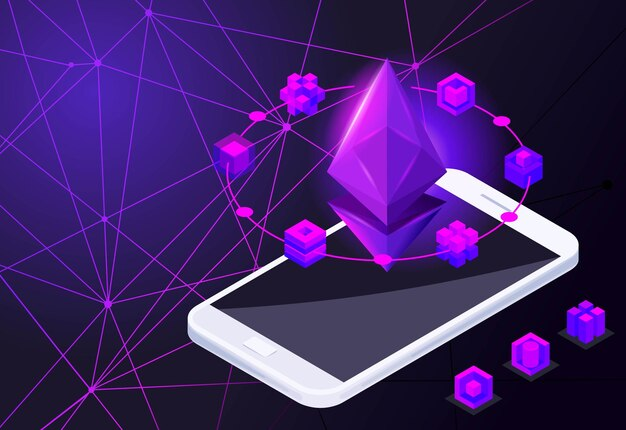Polygon, previously known as Matic Network, has emerged as one of the most significant projects in the blockchain space, offering solutions to the scalability issues that have long plagued Ethereum. As a Layer 2 scaling solution for Ethereum, Polygon enhances the performance of decentralized applications (dApps) and provides a more user-friendly experience by improving transaction speed and reducing costs. In this article, we’ll delve deep into what Polygon is, how it works, and why it’s an essential component in the future of decentralized finance (DeFi) and blockchain technology.
What is Polygon?
Polygon is a protocol and framework designed to build and connect Ethereum-compatible blockchain networks. Its primary objective is to address the scalability limitations of Ethereum by creating a multi-chain system, which is sometimes referred to as “the internet of blockchains.” While Ethereum is known for its decentralized applications and smart contract functionality, it faces challenges like high transaction fees and slow processing times during periods of high demand. Polygon solves these issues by providing Layer 2 scaling solutions that work alongside Ethereum’s main chain.
The Polygon network supports two types of scaling solutions: Plasma Chains and Proof of Stake (PoS) sidechains. Both of these enhance the speed and reduce the cost of transactions, making it more feasible for everyday users and developers to interact with Ethereum-based dApps.
How Does Polygon Work?
Polygon’s success lies in its ability to create an efficient bridge between Ethereum and Layer 2 scaling solutions. Here’s how its core technology works:
Plasma Chains
Plasma is one of the most important components of Polygon. It’s a framework that allows for the creation of child chains, which are smaller chains connected to the Ethereum mainnet. These child chains handle most of the transactions, processing them off the Ethereum main network. Once a transaction is processed on a child chain, only the final result is recorded on the main Ethereum chain, dramatically reducing congestion and lowering transaction costs.
Plasma ensures that users maintain the same level of security as Ethereum but with a more efficient transaction process. This solution makes Polygon an ideal choice for dApps that require high throughput, such as gaming, decentralized finance applications, and NFT marketplaces.
Proof of Stake (PoS) Sidechains
In addition to Plasma, Polygon also employs Proof of Stake (PoS) sidechains. These sidechains are independent from Ethereum but maintain compatibility with it. Validators in the PoS system are responsible for processing transactions and adding them to the sidechain. In return, they are rewarded with MATIC tokens, which is Polygon’s native cryptocurrency.
Because PoS sidechains are designed to offload transactions from the Ethereum network, they help in improving both speed and cost-effectiveness. With transaction fees often under a few cents, PoS sidechains make interacting with dApps far more accessible for users who may be deterred by Ethereum’s high gas fees.
The Polygon Bridge
The Polygon Bridge is another key feature of the network. It allows users to transfer assets seamlessly between the Ethereum mainnet and Polygon. This bridging function ensures that users can take advantage of the reduced costs and faster transaction times on Polygon without losing the security and decentralization benefits of Ethereum. With the Polygon Bridge, assets like Ethereum tokens (ERC-20) can be moved onto the Polygon network, where they can interact with dApps in a more cost-efficient way.
The Role of MATIC Token
MATIC is Polygon’s native cryptocurrency and plays several roles in the ecosystem. Initially launched as the token for Matic Network, it retained the same ticker after the rebranding to Polygon. MATIC is used for various functions, including paying for transaction fees, staking, and governance.
Transaction Fees
MATIC is the currency used to pay transaction fees within the Polygon network. Users benefit from significantly lower fees compared to Ethereum, making the network highly attractive for small-scale transactions, micro-payments, and dApp interactions. The reduction in costs is one of the primary reasons many DeFi projects have migrated to or integrated with Polygon.
Staking and Security
Polygon uses a Proof of Stake consensus mechanism to secure the network, and MATIC tokens are an integral part of this process. Validators on the network must stake MATIC tokens to participate in the validation process. In return for staking their tokens and validating transactions, these validators earn rewards in MATIC. Staking ensures that the network remains secure and decentralized, with validators incentivized to act honestly and efficiently.
Governance
In the future, MATIC will also be used for governance, giving token holders a say in the direction of the network. Through a decentralized governance model, users will be able to vote on proposed upgrades, changes to the network, and the allocation of resources within the Polygon ecosystem.
Advantages of Polygon Over Ethereum
Polygon has gained significant traction in the blockchain space because of the advantages it provides over the Ethereum network. Here are some of the key benefits:
Scalability
One of Polygon’s biggest selling points is its scalability. The Ethereum network, as it stands today, can only process around 30 transactions per second, which leads to congestion during times of high demand. Polygon, with its Layer 2 solutions like Plasma and PoS sidechains, can process thousands of transactions per second, enabling dApps to scale more effectively.
Lower Transaction Costs
High transaction fees (gas fees) on Ethereum have been a long-standing issue, particularly during periods of network congestion. For everyday users and developers alike, the cost of interacting with smart contracts or transferring assets can become prohibitively expensive. Polygon dramatically reduces transaction costs, with fees often only a fraction of a cent.
Faster Transaction Speeds
Ethereum’s block confirmation times can range from a few seconds to minutes, depending on network conditions. This can slow down the user experience for many dApps, especially those requiring near-instant confirmation. Polygon solves this problem by providing faster transaction finality, making interactions with the network almost instantaneous.
Ethereum Compatibility
Since Polygon is fully compatible with Ethereum, developers don’t need to rewrite their code to deploy dApps on the network. Polygon supports Ethereum’s existing smart contracts, making it a seamless transition for projects looking to move to Layer 2 without abandoning the Ethereum ecosystem. This has made Polygon the go-to solution for Ethereum developers who want to offer their users a better experience without sacrificing security or decentralization.
Polygon’s Growing Ecosystem
Polygon has become a popular destination for decentralized finance (DeFi) projects, non-fungible tokens (NFTs), and gaming dApps. Its growing ecosystem includes major DeFi platforms such as Aave, Sushiswap, and Curve, all of which have integrated with Polygon to offer users faster, cheaper transactions.
NFT platforms like OpenSea and Rarible have also integrated with Polygon to reduce the high gas fees associated with minting and trading NFTs on Ethereum. This integration has made it easier for artists and creators to sell their work without having to worry about excessive fees, expanding the adoption of NFTs.
Polygon’s low costs and fast transaction speeds have also made it a popular choice for blockchain-based games. Gaming platforms like Decentraland and The Sandbox have embraced Polygon, enabling players to interact with the game’s ecosystem without the financial burden that comes with using Ethereum.
Future Developments for Polygon
The future of Polygon looks promising as the team continues to develop new features and expand its ecosystem. One key focus is improving cross-chain compatibility, allowing Polygon to interact not only with Ethereum but also with other blockchain networks. This would further enhance Polygon’s status as an interoperable Layer 2 solution, positioning it as a central player in the multi-chain future of blockchain technology.
Additionally, Polygon is investing in improving its security and scalability even further through initiatives like Polygon SDK. This software development kit allows developers to create their own Ethereum-compatible chains, contributing to the broader goal of building a fully decentralized, multi-chain ecosystem.
Conclusion
Polygon has successfully positioned itself as a crucial player in the Ethereum scaling landscape. By offering fast, affordable, and scalable solutions through its Plasma Chains and Proof of Stake sidechains, it addresses many of Ethereum’s most pressing issues. Its easy integration with Ethereum, low transaction costs, and high transaction speeds make it a popular choice for both developers and users.
As its ecosystem continues to grow with DeFi, NFTs, and gaming platforms, Polygon is well on its way to becoming a major force in the blockchain world. For anyone interested in cryptocurrency, DeFi, or blockchain technology, It presents a compelling case as the go-to Layer 2 solution that enhances Ethereum’s capabilities while making it more accessible and user-friendly.










